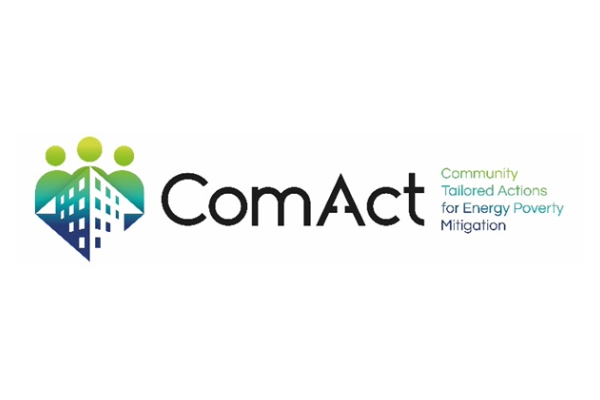
The countries in the Central and Eastern European (CEE) region and in the former Soviet Union republics (CIS region) have the most energy-poor people in Europe. Main reasons contributing to energy poverty of people with low income are high energy prices and poor energy efficiency of the buildings, building heating systems and household appliances.
The ComAct project has focused on these regions and in particular on their specificity that the housing stock (characterised with large percentage of multi-family apartment blocks) is predominantly in private ownership and consequently energy-poor households live in their privately-owned apartments. To address the complex roots of energy poverty, there was a need to develop a new approach in order to influence the energy costs substantially and make the energy efficiency (EE) interventions affordable, and consequently reduce the high energy poverty level in the CEE and CIS region. The ComAct project has aimed to make high-impact/high-cost energy-efficient improvements in multi-family apartment buildings in the CEE and CIS regions affordable and manageable for energy-poor communities as well as to create the necessary assistance conditions for lifting them out of energy poverty.
To achieve this main goal, firstly, an approach to identification and selection of energy-poor communities was developed, followed by interventions in three main dimensions: 1) empowering and activating the communities of homeowners’ associations; 2) developing/adapting financial tools that provide financing for low income families; and 3) optimising technical solutions that provide most favourable cost-benefit ratio for the energy efficient improvements at a multi-family apartment building level.
In order to demonstrate applicability, benefits and potential for alleviating energy poverty, 5 pilot cases were carried out that took place in Hungary, Bulgaria, North Macedonia, Lithuania and Ukraine.
Some concrete key performance indicators include:
- Primary energy savings triggered by the project
- Short-term impacts: Total 10.13 GWh/year
- Long-term minimum impacts: Total 15.13 GWh/year
- Long-term maximum impacts: Total 126.89 GWh/year
- Investments in sustainable energy triggered by the project
- Short-term impacts: 8.97 million EUR
- Long-term minimum impacts: Total 29.51 million EUR
- Long-term maximum impacts: Total 488.10 million EUR
- Reduction of greenhouse gases (GHG) emissions
- Short-term impacts: Total 3.65 ktCO2-eq/year
- Long-term minimum impacts: Total 4.65 ktCO2-eq/year
- Long-term maximum impacts: Total 38.30 ktCO2-eq/year
- Involvement of at least 10.000 consumers
- Short-term impacts: Total 3,320 consumers
- Long-term minimum impacts: Total 13,200 consumers
- Long-term maximum impacts: Total 44,472 consumers
- Contributions to EU/National policies and best practice on energy poverty
- Short-term impacts:
- Clean Energy for All Europeans Package
- Five pilot projects will show improved ways for metering and billing; Good practice examples added to the policy development in the national energy climate plans; Thematic policy briefings for policymakers; Two Knowledge Transfer Workshops, Mid-term Roundtable and Final Conference targeting policymakers on energy poverty; 500 stakeholders learn about multiple benefits within the project; Energy advice Resource Centres established.
- Long-term minimum impacts:
- National and local institutions of the pilot countries are aware of the ways energy poverty can be reduced; Residents of multifamily houses are actively joining HOAs; New Financial schemes introduced by ComAct are being used in all 5 pilot countries; 200 stakeholders learn about multiple benefits.
- Long-term maximum impacts:
- New financial schemes introduced by ComAct are being used in most of the Eastern European countries; National government and local financial institutions offer new financial schemes as their standard package and they are easy and openly accessed; 5000 stakeholders learn about multiple benefits.
- Short-term impacts:
Follow the project updates on Facebook and X (former Twitter). This page was last updated on 14 November 2023. For the most updated information about the project, please visit the EC Funding and Tender website and the website of the project.
- Project duration
- 1 Sep 2020 - 28 Feb 2024
- Project locations
- Budapest, HungaryBurgas, BulgariaKaisiadorys and Taurage, LithuaniaKarposh and Kavadarci, North MacedoniaOdessa, Ukraine
- Overall budget
- €1 987 224
- Project website
- ComAct
Stakeholders
Coordinators
[Lead Partner] Nadacia Habitat for Humanity International (NHFHI)
- Address
- Slovakia
Habitat for Humanity
- Address
- North Macedonia
ENOVA Consultants and Engineers
- Address
- Bosnia and Herzegovina
Alliance of Lithuanian Consumer Organisations (LVOA-ALCO)
- Address
- Lithuania
Buildings Performance Institute Europe (BPIE)
- Address
- Belgium
Housing Initiative for Eastern Europe (IWO)
- Address
- Germany
Centre for Energy Efficiency (EnEffect)
- Address
- Bulgaria
Metropolitan Research Institute (MRI)
- Address
- Hungary
Odessa Housing Union association (OHU)
- Address
- Ukraine
Burgas municipality
- Address
- Bulgaria
